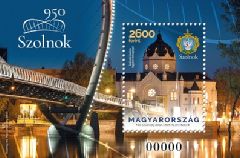
950 éves Szolnok - bélyegblokk
A Magyar Posta Szolnok fennállásának 950. évfordulójára alkalmi bélyegblokkot bocsát ki. A fekete sorszámú, perforált bélyegblokk 40.000, a piros sorszámú vágott változat 4000 példányban Baticz Barnabás grafikusművész tervei szerint a Pénzjegynyomda Zrt.-ben készült. Az újdonság 2025. szeptember 1-től megvásárolható a Filapostán, a filatéliai szakszolgálatokon, egyes postahelyeken és a posta.hu-n. Szolnok megyei jogú város, Jász-Nagykun-Szolnok vármegye székhelye, a Tisza és a Zagyva találkozásánál fekszik, fontos közlekedési és gazdasági csomópont. Körülbelül 66 ezer lakosával Magyarország 12. legnépesebb települése. Jelentős tranzit áruforgalmat bonyolít le közúton és vasúton egyaránt. A városban és környékén az autóalkatrész- és vasútigépgyártás, a vegyipar és a fafeldolgozó ipar fejlődött a legnagyobb mértékben. Napjainkban Szolnok a Tiszán átívelő hídjairól, a repülőmúzeumáról, Magyarország legrégebbi Művésztelepéről, színházáról, gazdag kulturális- és sportéletéről ismert. A terület a paleolitikumtól kezdve lakott volt. Szolnokot először 1075-ben említi I. Géza oklevele Zounok néven, a város nevét valószínűleg első ispánjáról kapta. A középkorban mezővárosként és vármegyei központként működött, fontos szerepet játszott az egyházi és közigazgatási életben. A tatárjárás után IV. Béla népesítette be újra. Luxemburgi Zsigmond uralkodása alatt vám és harmincadmentességet kapott, és fontos állami sóelosztó központtá vált. A török hódoltság idején stratégiai jelentősége megnőtt, mivel fontos átkelőhely volt a Tiszán. A második világháborúban súlyos károkat szenvedett, de gyorsan újjáépült. A Tiszántúl kapujaként pedig megőrizte központi, vezető szerepét a térségben. Az alkalmi bélyegblokkon esti kivilágításban a Tiszavirág híd és az egykori zsinagóga épülete, a mai Szolnoki Galéria látható. Az egymás közelében található két látványosság több mint száz év eltéréssel épült: a 2011-ben átadott, kerékpárúttal ellátott gyaloghíd a belvárost köti össze a Tiszaligettel; az 1898-ban épült Szolnoki Zsinagóga épülete pedig ma a művészeti kiállításoknak otthont adó Szolnoki Galéria. Az alkalmi boríték a Tiszai hajósok terét mutatja be háttérben a Tiszavirág híddal. Az elsőnapi bélyegzésű alkalmi borítékon (FDC) található bélyegző lenyomatán a jubileumi év logója jelenik meg.
950 years of Szolnok - stamp sheet
Magyar Posta is issuing a commemorative souvenir sheet to celebrate the 950th anniversary of the foundation of the city of Szolnok. Forty thousand copies of the black numbered perforated souvenir sheets and 4,000 copies of the red numbered imperforated souvenir sheets designed by the graphic artist Barnabás Baticz were produced by the banknote printing company Pénzjegynyomda Zrt. The new issue goes on sale at Filaposta, philately specialist services, certain post offices and posta.hu from 1 September 2025. Szolnok, a city with county rights and the seat of Jász-Nagykun-Szolnok county, is an important transport and economic hub located at the confluence of the Tisza and Zagyva rivers. It has a population of around 66,000 people, making it the 12th most populous city in Hungary. The volume of goods transiting the city by both road and rail is significant. In and around Szolnok, the automotive component and railway machinery manufacturing, as well as the chemical and wood processing industries have developed to the greatest extent. Today, Szolnok is known for its bridges over the Tisza, its aviation museum, Hungary’s oldest artists’ colony, its theatre, and its rich cultural and sporting life. The area has been inhabited since the Palaeolithic. Szolnok was first mentioned as Zounok in a charter of Géza I dating from 1075. The town was probably named after its first sheriff. In the Middle Ages, it was a market town and a county centre, and played an important role in ecclesiastical and administrative life. After its destruction during the Mongol invasion, it was repopulated under Béla IV. During the reign of Sigismund of Luxembourg, it was exempted from customs duty and the thirtieth, a foreign trade tax, and became an important national centre for the distribution of salt. Its strategic importance grew during the Turkish occupation, as it was a major crossing point on the Tisza. The city was severely damaged during the Second World War but was quickly rebuilt. As the gateway to the Transtisza region, it has retained its central, leading role in the area. The Tiszavirág Bridge and the former synagogue building, today the Szolnok Gallery, lit in the evening can be seen on the souvenir sheet. The two landmarks, located near each other, were built more than 100 years apart: the pedestrian bridge with a cycle path, opened in 2011, connects the city centre with the Tiszaliget district, while the Szolnok Synagogue, built in 1898, is now the Szolnok Gallery, providing a venue for art exhibitions. The commemorative first day cover shows Tisza Boatmen’s Square with the Tiszavirág Bridge in the background. The logo of the jubilee year appears in the imprint of the postmark on the commemorative first day cover.










